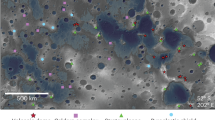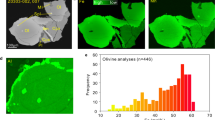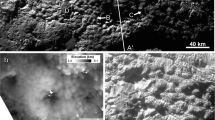Abstract
Non-basaltic volcanism is rare on the Moon. The best known examples occur on the lunar nearside in the compositionally evolved Procellarum KREEP terrane. However, there is an isolated thorium-rich area—the Compton–Belkovich thorium anomaly—on the lunar farside for which the origin is enigmatic. Here we use images from the Lunar Reconnaissance Orbiter Cameras, digital terrain models and spectral data from the Diviner lunar radiometer to assess the morphology and composition of this region. We identify a central feature, 25 by 35 km across, that is characterized by elevated topography and relatively high reflectance. The topography includes a series of domes that range from less than 1 km to more than 6 km across, some with steeply sloping sides. We interpret these as volcanic domes formed from viscous lava. We also observe arcuate to irregular circular depressions, which we suggest result from collapse associated with volcanism. We find that the volcanic feature is also enriched in silica or alkali-feldspar, indicative of compositionally evolved, rhyolitic volcanic materials. We suggest that the Compton–Belkovich thorium anomaly represents a rare occurrence of non-basaltic volcanism on the lunar farside. We conclude that compositionally evolved volcanism did occur far removed from the Procellarum KREEP terrane.
This is a preview of subscription content, access via your institution
Access options
Subscribe to this journal
Receive 12 print issues and online access
$259.00 per year
only $21.58 per issue
Buy this article
- Purchase on Springer Link
- Instant access to full article PDF
Prices may be subject to local taxes which are calculated during checkout






Similar content being viewed by others
References
Lawrence, D. J. et al. High resolution measurements of absolute thorium abundance on the lunar surface. Geophys. Res. Lett. 26, 2681–2683 (1999).
Lawrence, D. J. et al. Small-area thorium features on the lunar surface. J. Geophys. Res. 108, JE002050 (2003).
Lawrence, D. J. et al. Global spatial deconvolution of Lunar Prospector Th abundances. Geophys. Res. Lett. 34, L03201 (2007).
Gillis, J. J., Jolliff, B. L., Lawrence, D. J., Lawson, S. L. & Prettyman, T. H. The Compton–Belkovich region of the Moon: Remotely sensed observations and lunar sample association. Lunar Planet. Sci. 33, abstr. no. 1967 (2002).
Robinson, M. S. et al. Lunar Reconnaissance Orbiter Camera (LROC) instrument overview. Space Sci. Rev. 150, 81–124 (2010).
Tran, T. et al. Generating digital terrain models from LROC stereo images with SOCET SET. Lunar Planet. Sci. 41, abstr. no. 2515 (2010).
Scholten, F. et al. Towards global lunar topography using LROC WAC stereo data. Lunar Planet. Sci. 41, abstr. no. 2111 (2010).
Zuber, M. T. et al. The Lunar Orbiter Laser Altimeter investigation on the Lunar Reconnaissance Orbiter mission. Space Sci. Rev. 150, 63–80 (2010).
Lawrence, S. J. et al. LROC observations of the Marius Hills. Lunar Planet. Sci. 41, abstr. no. 1906 (2010).
Murase, T. & McBirney, A. R. Viscosity of lunar lavas. Science 167, 1491–1493 (1970).
Li, L. & Mustard, J. F. Compositional gradients across mare-highland contacts: Importance and geological implication of lateral transport. J. Geophys. Res. 105, 20431–20450 (2000).
Lawrence, D. J. et al. Iron abundances on the lunar surface as measured by the Lunar Prospector gamma-ray and neutron spectrometers. J. Geophys. Res. 107, JE001530 (2002).
Ryder, G. Lunar sample 15405: Remnant of a KREEP basalt-granite differentiated pluton. Earth Planet. Sci. Lett. 29, 255–268 (1976).
Warren, P. H. et al. Seventh foray: Whitlockite-rich lithologies, a diopside-bearing troctolitic anorthosite, ferroan anorthosites, and KREEP. Proc. Lunar Planet. Sci. Conf. 14th in J. Geophys. Res. 88, B151–B164 (1983).
Warren, P. H., Jerde, E. A. & Kallemeyn, G. W. Pristine Moon rocks: A ‘large’ felsite and a metal-rich ferroan anorthosite. Proc. Lunar. Planet. Sci. Conf. 17th in J. Geophys. Res. 92, E303–E313 (1987).
Marvin, U. B., Lindstrom, M. M., Holmberg, B. B. & Martinez, R. R. New observations on the quartz monzodiorite-granite suite. Proc. Lunar Planet. Sci. 21, 119–135 (1991).
Jolliff, B. L. Fragments of quartz monzodiorite and felsite in Apollo 14 soil particles. Proc. Lunar Planet. Sci. 21, 101–118 (1991).
Snyder, G. A., Taylor, L. A. & Halliday, A. Chronology and petrogenesis of the lunar highlands alkali suite: Cumulates from KREEP basalt crystallization. Geochim. Cosmochim. Acta 59, 1185–1203 (1995).
Seddio, S. M., Jolliff, B. L., Korotev, R. L. & Zeigler, R. A. A newly characterized granite from the Apollo 12 regolith. Lunar Planet. Sci. 40, abstr. no. 2285 (2009).
Seddio, S. M., Korotev, R. L., Jolliff, B. L. & Zeigler, R. A. Comparing the bulk compositions of lunar granites, with petrologic implications. Lunar Planet. Sci. 41, abstr. no. 2688 (2010).
Jolliff, B. L. Large-scale separation of K-frac and REEP-frac in the source regions of Apollo impact-melt breccias, and a revised estimate of the KREEP composition. Int. Geology Rev. 40, 916–935 (1998).
Paige, D. A. et al. The Lunar Reconnaissance Orbiter Diviner Lunar Radiometer Experiment. Space Sci. Rev. 150, 125–160 (2010).
Greenhagen, B. T. et al. Global silicate mineralogy of the Moon from the Diviner lunar radiometer. Science 329, 1507–1509 (2010).
Glotch, T. D. et al. Identification of highly silicic features on the Moon. Science 329, 1510–1513 (2010).
Wilhelms, D. E. in The geologic history of the Moon Vol. 1348 (US Geol. Surv. Prof. Paper, United States Government Printing Office, 1987).
Jolliff, B. L., Gillis, J. J., Haskin, L., Korotev, R. L. & Wieczorek, M. A. Major lunar crustal terranes: Surface expressions and crust-mantle origins. J. Geophys. Res. 105, 4197–4216 (2000).
Taylor, G. J., Warner, R. D., Keil, K., Ma, M-S. & Schmitt, R. A. in Proceedings of the Conference on the Lunar Highlands Crust (eds Papike, J. J. & Merrill, R. B.) 339–352 (Geochim. Cosmochim. Acta: Supplement, 12, Pergamon, 1980).
Longhi, J. Silicate liquid immiscibility in isothermal crystallization experiments. Proc. Lunar Planet. Sci. Conf. 20, 13–24 (1990).
McBirney, A. R. & Nakamura, Y. Immiscibility in late-stage magmas of the Skaergaard intrusion. Carnegie Inst. Wash. Yearb. 73, 348–352 (1974).
Hawke, B. R. et al. Hansteen Alpha: A volcanic construct in the lunar highlands. J. Geophys. Res. 108, E002013 (2003).
Chevrel, S. D., Pinet, P. C. & Head, J. W. III Gruithuisen domes region: A candidate for an extended nonmare volcanism unit on the Moon. J. Geophys. Res. 104, 16515–16529 (1999).
Wilson, L. & Head, J. W. Lunar Gruithuisen and Mairan domes: Rheology and mode of emplacement. J. Geophys. Res. 108, 5012 (2003).
Hagerty, J. J. et al. Refined thorium abundances for lunar red spots: Implications for evolved, nonmare volcanism on the Moon. J. Geophys. Res. 111, E06002 (2006).
Lawrence, S. J. et al. Composition and origin of the Dewar geochemical anomaly. J. Geophys. Res. 113, E02001 (2008).
Tran, T. et al. Morphometry of lunar volcanic domes from LROC. Lunar Planet. Sci. 42, abstr. no. 2228 (2011).
Wieczorek, M. A. & Phillips, R. J. Potential anomalies on a sphere: Application to the thickness of the lunar crust. J. Geophys. Res. 103, 1715–1724 (1998).
Wieczorek, M. A. et al. in New Views of the Moon Vol. 60 (eds Jolliff, B. L., Wieczorek, M. A., Shearer, C. K. & Neal, C. R.) 221–364 (Mineralogical Society of America, 2006).
Tran, T. et al. Generating digital terrain models using LROC NAC images. Joint Symposium of ISPRS Technical Commission IV & AutoCarto in conjunction with ASPRS/CaGIS 2010 Fall Specialty Conference, Nov. 15–19, Orlando, Florida.
Scholten, F. et al. Towards global lunar topography using LROC WAC stereo data. Lunar Planet. Sci. 41, abstr. no. 2111 (2010).
Acknowledgements
The authors thank the LRO, LROC, and Diviner operations teams for their work and NASA ESMD and SMD for support of the LRO mission. The authors thank N. Petro for comments, which led to significant improvements in the manuscript.
Author information
Authors and Affiliations
Contributions
B.L.J. drafted the initial manuscript. S.A.W. processed WAC images and DTMs, and assisted with NAC image processing. S.J.L. worked with B.L.J. on the topic of lunar red spots and volcanic domes. M.S.R is the principal investigator of the LRO Cameras, was responsible for development and operation of the camera system, and contributed to scientific interpretations. F.S. and J.O. of DLR derived and provided the WAC DTM. T.N.T. processed and provided the NAC DTMs and first characterized the ‘big dome.’ S.J.L., M.S.R., B.R.H., H.H., and C.H.v.d.B. provided input on geological relationships and contributed to writing the paper. H.S. provided data for reflectance analysis. B.T.G. and D.A.P. provided the Diviner data, T.D.G. contributed to interpretation of the CF, and D.A.P. is the principal investigator of the Diviner lunar radiometer. All of the authors contributed to assessment and discussion of the results.
Corresponding author
Ethics declarations
Competing interests
The authors declare no competing financial interests.
Supplementary information
Supplementary Information
Supplementary Information (PDF 1865 kb)
Rights and permissions
About this article
Cite this article
Jolliff, B., Wiseman, S., Lawrence, S. et al. Non-mare silicic volcanism on the lunar farside at Compton–Belkovich. Nature Geosci 4, 566–571 (2011). https://doi.org/10.1038/ngeo1212
Received:
Accepted:
Published:
Issue Date:
DOI: https://doi.org/10.1038/ngeo1212
This article is cited by
-
Remote detection of a lunar granitic batholith at Compton–Belkovich
Nature (2023)
-
Exotic clasts in Chang’e-5 regolith indicative of unexplored terrane on the Moon
Nature Astronomy (2022)
-
The search for lunar mantle rocks exposed on the surface of the Moon
Nature Communications (2021)
-
Retrieving magma composition from TIR spectra: implications for terrestrial planets investigations
Scientific Reports (2019)



